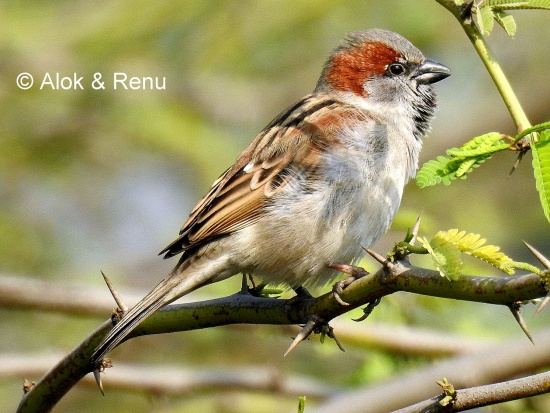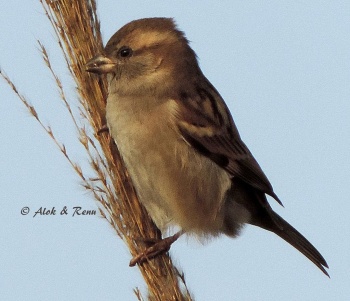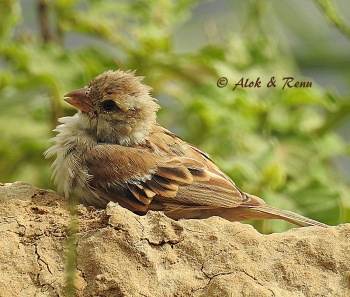Alternative names: Sind Jungle Sparrow; Rufous-backed Sparrow
- Passer pyrrhonotus
Identification
12.5 - 13cm (5 in);
A small version of House Sparrow:
Male
- Greyer crown, nape and cheek
- Warm brown lower back and rump
- Small narrow black bib just reaching breast
- Chestnut eyestripe
- Mantle paler rufous brown than House Sparrow
- Black bill
Female
Very similar to female House Sparrow. Juveniles are similar to females.
Similar species
Similar to House Sparrow. Note in males black bib just reaching breast and greyer crown, nape and cheek. Also the chestnut eyestripe doesn't reach the mantle. Females resemble female House Sparrow very closely but are slightly darker, more uniformly coloured on upperparts and have a darker and more chestnut shoulder.
Distribution
Found in the Indus valley in Pakistan and east into Punjab and Dehli area in India.
Locally common. The expansion into India happened quite recently. Old reports from Iran need confirmation.
Taxonomy
This is a monotypic species[1].
In the past believed to be a small subspecies of House Sparrow.
Habitat
Tall grass, tamarisk and acacia jungle in riverine or swampy areas. Not particularly associated with humans.
Behaviour
Diet
Feeds on seeds of grasses and small herbs. May also take some invertebrates.
Forages mainly in small flocks of up to 20 birds outside breeding season.
Breeding
Breeding season from April to September. Breeds in loose colonies. The nest is an untidy globular construction made of grass, reeds and coarse twigs. It's placed in the branches of a low tree standing in or overhanging water. Lays 3 - 5 eggs.
Movements
A resident species.
Vocalisation
Recording by Alok Tewari
Dist. Gurgaon, Haryana, India, Feb-2016
Male singing - Beginning of Spring
References
- Clements, J. F., T. S. Schulenberg, M. J. Iliff, D. Roberson, T. A. Fredericks, B. L. Sullivan, and C. L. Wood. 2014. The eBird/Clements checklist of birds of the world: Version 6.9., with updates to August 2014. Downloaded from http://www.birds.cornell.edu/clementschecklist/download/
- Del Hoyo, J, A Elliott, and D Christie, eds. 2009. Handbook of the Birds of the World. Volume 14: Bush-shrikes to Old World Sparrows. Barcelona: Lynx Edicions. ISBN 978-8496553507
- Rasmussen, PC and JC Anderton. 2005. Birds of South Asia: The Ripley Guide. Barcelona: Lynx Edicions. ISBN 978-8487334672
Recommended Citation
- BirdForum Opus contributors. (2024) Sind Sparrow. In: BirdForum, the forum for wild birds and birding. Retrieved 8 November 2024 from https://www.birdforum.net/opus/Sind_Sparrow
External Links
GSearch checked for 2020 platform.1






